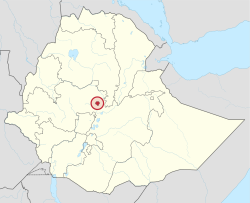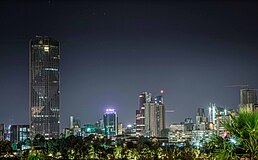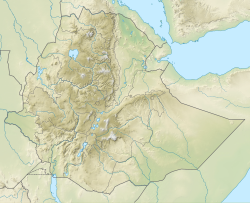Addis Ababa
| |
|---|---|
| Nicknames: City of Humans, Sheger, Adu Genet | |
 Addis Ababa highlighted inside of Ethiopia | |
| Coordinates: 9°1′48″N 38°44′24″E / 9.03000°N 38.74000°E | |
| Country | Ethiopia |
| Founded | 1886 |
| Incorporated as capital city | 1889 |
| Founded by | |
| Government | |
| • Mayor | Adanech Abebe |
| Area | |
• Capital and chartered city | 527 km2 (203 sq mi) |
| • Land | 527 km2 (203 sq mi) |
| [1] | |
| Elevation | 2,355 m (7,726 ft) |
| Population (2007)[2] | |
• Capital and chartered city | 2,739,551 |
• Estimate (2023)[3] | 3,945,000 |
| • Density | 5,165.1/km2 (13,378/sq mi) |
| • Metro | 5,704,000 |
| Demonym | Addis Ababan |
| Time zone | UTC+3 (East Africa Time) |
| Area code | (+251) 11 |
| HDI (2021) | 0.741[4] high · 1st of 11 |
| Website | cityaddisababa |
Addis Ababa (/ˌædɪs ˈæbəbə/;[5]Amharic: አዲስ አበባ, lit. 'new flower' [adˈdis ˈabəba] ) is the capital and largest city of Ethiopia.[6][7][8] In the 2007 census, the city's population was estimated to be 2,739,551 inhabitants.[2] Addis Ababa is a highly developed[9] and important cultural, artistic, financial and administrative center of Ethiopia. It is widely known as one of Africa's major capitals.[10]
The founding history of Addis Ababa dates back to the late 19th century by Menelik II, Negus of Shewa, in 1886 after finding Mount Entoto unpleasant two years prior.[11] At the time, the city was a resort town; its large mineral spring abundance attracted nobilities of the empire and led them to establish permanent settlement. It also attracted many members of the working classes – including artisans and merchants – and foreign visitors. Menelik II then formed his imperial palace in 1887.[12][13] Addis Ababa became the empire's capital in 1889, and subsequently international embassies were opened.[14][15] Urban development began with the 20th century, without any prior planning.[11]
Addis Ababa saw a wide-scale economic boom in 1926 and 1927, and an increase in the number of buildings owned by the middle class, including stone houses filled with imported European furniture. The middle class also imported newly manufactured automobiles and expanded banking institutions.[14] During the Italian occupation, urbanization and modernization steadily increased through a masterplan; it was hoped Addis Ababa would be a more "colonial" city and continued on after the occupation. Subsequent master plans were designed by French and British consultants from the 1940s onwards, focusing on monuments, civic structures, satellite cities and the inner-city. Similarly, the later Italo-Ethiopian masterplan (also projected in 1986) concerned only urban structure and accommodation services, but was later adapted by the 2003 masterplan.
Addis Ababa is a federally-chartered city in accordance with the Addis Ababa City Government Charter Proclamation No. 87/1997 in the FDRE Constitution.[16] Called "the political capital of Africa" due to its historical, diplomatic, and political significance for the continent, Addis Ababa serves as the headquarters of major international organizations, such as the African Union and the United Nations Economic Commission for Africa.[17]
The city lies a few kilometres west of the East African Rift, which splits Ethiopia into two, between the Nubian Plate and the Somali Plate.[18] The city is surrounded by the Special Zone of Oromia, and is populated by people from different regions of Ethiopia. It is home to Addis Ababa University. The city has a high human development index, and is known for its vibrant culture, strong fashion scene, high civic and political involvement of younger people, a thriving arts scene, and for being the heart of a country with one of the fastest economic growth rates in the world.[19]
- ^ "2011 National Statistics". Csa.gov.et. Archived from the original on 30 March 2013. Retrieved 20 July 2013.
- ^ a b "Census 2007 Tables: Addis Abeba" Archived 14 November 2010 at the Wayback Machine, Tables 2.1, 2.5, 3.1, 3.2 and 3.4. For Silt'e, the statistics of reported Shitagne speakers were used, on the assumption that this was a typographical error.
- ^ "Population Size by Sex Zone and Wereda July 2023" (PDF). Ethiopian Statistics Agency. 2023. Retrieved 19 August 2023.
- ^ "Sub-national HDI – Area Database – Global Data Lab". globaldatalab.org. Archived from the original on 25 June 2020. Retrieved 14 May 2020.
- ^ "Addis Ababa – English Definition and Meaning". Lexico.com. Archived from the original on 4 February 2022. Retrieved 28 February 2022.
- ^ Ethiopia in Brief, n.d., archived from the original on 28 December 2021, retrieved 20 April 2021
- ^ "Oromia Regional State". Ethiopia. Archived from the original on 28 July 2017. Retrieved 2 June 2020.
- ^ "| Human Development Reports". hdr.undp.org. Retrieved 9 November 2021.
- ^ Cite error: The named reference
:5was invoked but never defined (see the help page). - ^ "Addis Ababa | national capital, Ethiopia". Encyclopædia Britannica. Retrieved 9 February 2019.
- ^ a b Cite error: The named reference
:2was invoked but never defined (see the help page). - ^ "Ethiopia's Imperial Palace opened to the public after more than a century". This is africa. 30 October 2019. Archived from the original on 12 February 2022. Retrieved 12 February 2022.
- ^ "Ethiopia opens doors to its Imperial Palace for the first time". Embassy of Ethiopia, London. 16 October 2019. Archived from the original on 12 February 2022. Retrieved 12 February 2022.
- ^ a b Anacker, Caelen (16 March 2010). "Addis Ababa, Ethiopia (1886– ) •". Archived from the original on 5 January 2022. Retrieved 5 January 2022.
- ^ Benti, Getahun (2000). "A History of Addis Ababa from Its Foundation in 1886 to 1910 (review)". Northeast African Studies. 7 (2): 143–145. doi:10.1353/nas.2004.0013. ISSN 1535-6574. S2CID 144623037. Archived from the original on 2 July 2022. Retrieved 15 December 2021.
- ^ Federal Negarit Gazeta. 2003. p. 1.
- ^ "United Nations Economic Commission for Africa". UNECA. Archived from the original on 24 April 2012. Retrieved 5 May 2012.
- ^ Gizaw, Berhanu. "The origin of high bicarbonate and fluoride concentrations in waters of the Main Ethiopian Rift Valley, East African Rift system." Journal of African Earth Sciences 22.4 (1996): 391–402.
- ^ James Jeffrey. "Addis Ababa: 10 best things to do in Ethiopia's capital". CNN. Archived from the original on 1 November 2021. Retrieved 9 November 2021.











